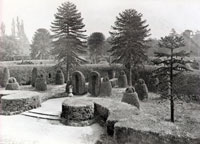
The land was passed through several families until it was acquired by the Stanhope Family in 1607. It remained with this family for well over 400 years, until its sale in the late 1960s. At this point in its history Elvaston may already have included significant gardens, partially walled with stone or terraced.
The estate was undoubtedly affected by many subsequent events and heirs, such as the Civil War in 1643, when Sir John Gell (Governor of Derby) ransacked the house for arms as the family supported King Charles I. Each successive Stanhope heir influenced the development of the estate – with William Stanhope being created the first Baron Harrington in 1730, rising in 1742, to become the first earl. His elevation may have inspired him to make his estate and surrounding land more productive, as many changes took place following his rise.
Subsequent earls continued to improve the estate, with perhaps the most well-known being the fourth earl. He worked alongside William Barron, whom he had made head gardener, between 1830 until his death in 1851, to establish much of the character of the park and gardens as they can be seen today. Barron himself continued working, with a much reduced gardening staff, with the fifth and sixth earls until he left Elvaston in 1865.
The Stanhope family and 11th earl finally left the estate in 1939 at the onset of the war. During the War, Elvaston housed a teacher training college and in 1964 the estate was put up for sale. It was purchased by Needlers (subsequently part of Tarmac Roadstone UK), a mineral extraction company, with the central core of the estate subsequently being sold to us and Derby Borough Council in 1969, saving it from being exploited as a series of gravel pits.
In 1970 the park was officially designated a country park and opened to the public.